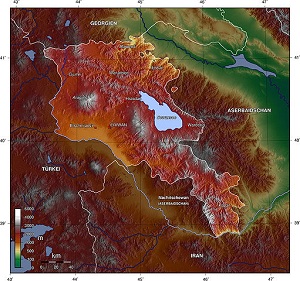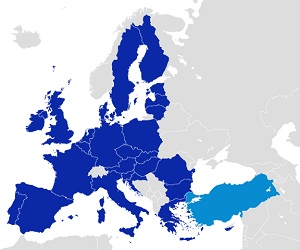Friday: Possibility
Let’s try a Swedish import today, a little something I can’t really classify by a particular genre. This piece is one of my favorites, one of the most haunting tunes I’ve ever heard. It’s probably dream pop for lack of a better label. Lykke Li’s most popular works tend toward indie and synth-pop, sharing a strong rhythm and English lyrics melded with Lykke Li’s unearthly vocals.
Try out I Follow Rivers (dance/synth-pop) and Sadness Is A Blessing (retro indie pop) for comparison. The latter in particular has a funky video featuring another famous Swedish artist, Stellan Skarsgård. Love his understated effort which acts like a punctuation to the singer’s work.
Speaking of Sweden…
Carl Bildt, a former prime minister of Sweden (1991-1994) and former Minister for Foreign Affairs (2006-2014), tweeted on Wednesday:
I never thought a serious candidate for US President could be a serious threat against the security of the West. But that’s where we are.
Bildt is known for his conservative politics and neoliberal business ethics. Pretty sure he wasn’t referring to Clinton.
Turkic troubles
- Insane numbers of people arrested or detained after Turkey’s anti-Gülenist crackdown (EWN) — Graphic in article offers a breakdown. Doesn’t break out the journalists arrested; see Mahir Zeynalov’s timeline for a journo-by-journo roll call.
- UN Special Rapporteur and OSCE worried about Turkey’s journalists (OSCE) — UN Special Rapporteur on the right to freedom of opinion and expression and the Organization for Security and Cooperation in Europe Representative on Freedom of the Media condemned President Erdoğan’s purge of journalism attacking free speech. The numbers bolster their concerns:
Reports indicate that the Government ordered the closure of three news agencies, 16 TV channels, 23 radio channels, 45 papers and 15 magazines. Since the attempted coup, authorities have issued arrest warrants against 89 journalists and have already arrested several of them, blocked access to more than 20 news websites, revoked the licenses of 29 publishing houses, and cancelled a number of press accreditations.
- Generals stepped down as military rejiggered (Euronews) — Looks like the president is grabbing power over the military in the same way the judiciary’s independence has now been smashed by removals from office. Hey, anybody worried at all about Incirlik air base while the Turkish military is reformulated?
Economic emesis
- Investors ‘totally lost’ (Business Insider) — Credit Suisse’s clients are casting about for direction because there’s no strong performance in the market across any industry, and indicators are confusing:
Here’s a summary of what clients are worried about: workers fighting back in the US, hitting earnings; equities still not cheap; US growth mixed; China still screwed; central banks’ empty policy cupboards; politics being nuts (protectionism, anti-immigration moves, anticorporate feeling); and technology running rampant and destroying business models.
Yeah, about the “workers fighting back”…perhaps if workers were better paid, making a living wage, all of the confusion would evaporate as consumption improved. There’s a reason home ownership rates have dropped below 1965 levels and it’s not because Millennials don’t want them (really crappy blame-casting, CNBC, catch the cluestick).
- Nevada utilities commish not reappointed due to solar energy rate structure (Las Vegas Sun) — Something about this story tweaks my hinky-meter. Maybe a certain commissioner has friends who don’t want solar energy to become competitive? Which is really a shame considering the Tesla’s new Wonderwall battery plant now in the Reno area.
- Five-year-long shortage of cancer drug forces reliance on disqualified Chinese maker (Bloomberg) — There’s been a shortage of doxorubicin since 2011, and companies the size of Pfizer — the largest pharma company in the world — rely on a facility in China banned by the FDA because of quality problems like contamination. What the hell is wrong with this picture?
- Kazahk emigre sentenced for export violations (The Hill) — How did this guy pull off exporting dual-use technology to Russia for ten years? Doesn’t look like it took much effort based on available information. Have we cut regulatory oversight so much and been so distracted at the same time that we’ve given away the farm?
Something STEMmed
- TSA’s keys compromised (TechCrunch) — Hacking’s not just for software. All seven of TSA’s master keys have been cloned; anybody can 3D print one and unlock baggage with TSA-approved padlock. Why even bother locking stuff? Of course bags can be so damaged during handling the lock may be worthless anyhow. Makes you wonder how many other physical security devices can be defeated with 3D printing.
- Bees’ sperm dramatically affected by insecticides (SFGate) — Hey dudes, especially you in Congress. Maybe you ought to ask if insecticides reduce bees’ sperm production by 40% whether human sperm might also be similarly affected? Just sayin’.
- Huge great white shark trolls family’s boat off east coast (Cape Cod Chronicle) — But there’s an app for that; they could ‘see’ him coming, thanks to an app which monitored the tag. Mixed feelings on this: glad the family was safe, but jeepers, how else can this tag be used?
Oikonomia
How screwed up is the United Kingdom post-referendum vote and how jacked up is the current economic system, when a disabled theoretical physicist and cosmologist must beg in an op-ed for his country to reconsider its understanding and reaction to wealth?
Worth recalling the word ‘economics’ originated from the Greek ‘oikonomia’, meaning “household management.”
Have a safe, relaxing weekend!



![[image: Leo Reynolds via Flickr]](https://www.emptywheel.net/wp-content/uploads/2016/02/LettersTh_LeoReynolds-Flickr.jpg)